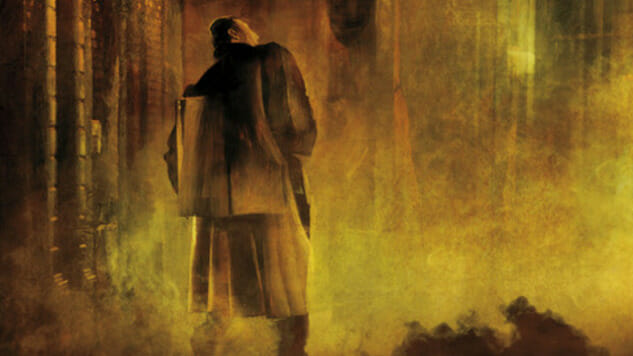Dave McKean’s Cages 25th Anniversary Edition Pushes Words & Pictures to Their Limit
Art by Dave McKean
Writer/Artist: Dave McKean
Publisher: Dark Horse
Release Date: November 2, 2016
 Dave McKean’s array of skills can, at times, induce paroxysms of envy. He’s probably best known for his collaborations with Neil Gaiman, on everything from a John Constantine story to the covers for Sandman to the film MirrorMask, where McKean directed Gaiman’s screenplay. But McKean is also a fantastic writer in his own right, and Cages is a sterling example of that fact. Originally released in single-issue form from 1990 to 1996, this latest edition adds a few new features, including a glimpse of McKean’s sketchbook and an introduction by McKean’s cohort in the surreal and multidisciplinary, Terry Gilliam. And it’s a powerful and singular work, one that encompasses the quotidian, the surreal and the grandiose—often on the same page.
Dave McKean’s array of skills can, at times, induce paroxysms of envy. He’s probably best known for his collaborations with Neil Gaiman, on everything from a John Constantine story to the covers for Sandman to the film MirrorMask, where McKean directed Gaiman’s screenplay. But McKean is also a fantastic writer in his own right, and Cages is a sterling example of that fact. Originally released in single-issue form from 1990 to 1996, this latest edition adds a few new features, including a glimpse of McKean’s sketchbook and an introduction by McKean’s cohort in the surreal and multidisciplinary, Terry Gilliam. And it’s a powerful and singular work, one that encompasses the quotidian, the surreal and the grandiose—often on the same page.
Cages opens with an array of short prose pieces, each a variation on the idea of a creation story. This is one of several motifs that McKean revisits over the course of the book—both the creation of the cosmos and the making of art. Leo Sabarsky, the central character of Cages, moves into a new apartment and finds that several of his neighbors are also involved in artistic disciplines, including Jonathan, a novelist, and Angel, a musician and poet. Leo struggles with being artistically blocked, wanders through the city, and begins to make connections with some of his fellow residents. Over time, the narrative evokes both the mundane work of attempting to find inspiration alongside surreal moments, including the appearance of a preternaturally intelligent cat and a group of sinister men who seem to have wandered in from a more Kafka-esque narrative.

Cages Interior Art by Dave McKean
The title of the book assumes a host of meanings as the book proceeds: a novel called Cages plays a part in the graphic novel’s plot, and several of the characters are, metaphorically (and, in one case, metaphysically), imprisoned. A parrot residing in a cage factors heavily in one of the sequences. And, more broadly, McKean frequently uses a nine- or sixteen-panel grid, which also imposes a cage-like design on the page.
-

-

-

-

-

-

-

-

-

-

-

-

-

-

-

-

-

-

-

-

-

-

-

-

-

-

-

-

-

-

-

-

-

-

-

-

-

-

-

-












































